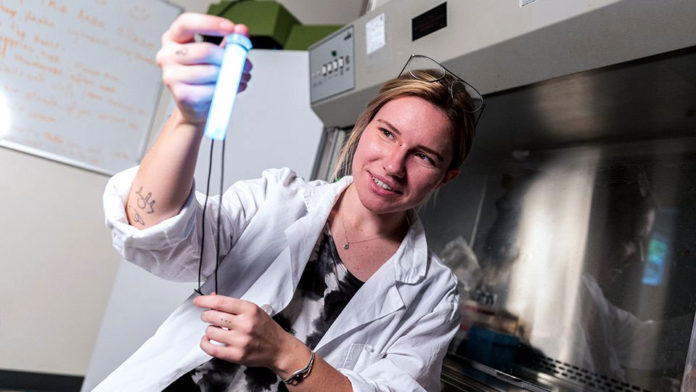Glow sticks light up the night at big events like fireworks and music festivals, but it comes at a cost. Every year, over 100 million plastic glow sticks are discarded.
Beyond plastic waste, glow sticks also contain toxic and carcinogenic chemicals that drive the glow reaction, like dibutyl phthalate. And sadly, they’re rarely disposed of properly, meaning a lot of litter and unmanaged hazardous waste ends up in our landfills, soil, and waterways.
Festival goer and scientist Paige Whitehead, undergraduate student of microbiology and environmental studies at the University of Victoria, grew tired of seeing discarded glow sticks littering the ground. She kept coming back to the idea that there had to be a more environmentally friendly way to party.
So she designed a protein-based bioluminescent glow stick and founded her own company, Nyoka Design. Her company is supported by the Coast Capital Savings Innovation Centre, an on-campus business incubator at the University of Victoria.
You might recognize bioluminescent reactions from seeing them in nature. Fireflies, jellyfish, and glow worms are all popular examples of animals that use bioluminescence. Having the ability to light up can help animals with anything from attracting mates and luring prey to camouflaging against a bright background.
It all started by sending emails to researchers working in bioluminescence, says Whitehead. That feathered out into a whole network of connections that helped her harness bioluminescent reactions to generate a viable light source.
Whitehead credits a community of scientists, innovators, artists, and friends for helping her bring her idea to market. The result is the Nyoka Light Wand, the world’s first protein-based light source, set to launch this summer.
Even the wand’s casing is fully compostable, making use of a translucent seaweed-based material that can degrade wherever it lands.
Users simply add water, close up the reusable cap, puncture the top, and shake to activate the bioluminescent glow reaction. It glows intensely for 30-60 minutes, and fades to a more gentle glow that can last for a few more hours.
But Whitehead didn’t stop at making a product with safer materials that might have a neutral impact on the planet. She wanted her Light Wands to actually improve the soil where users discard them.
“I studied permaculture design and am really interested in how you can improve on systems to heal the environment, not just stop the harm to it,” said Whitehead in a statement.
Whitehead is already prototyping a version that will incorporate mushroom spores to help nourish the soil.
Tackling the problem of glow stick waste is a brilliant example of ecologically-minded design. By stopping a mindless pattern of littering the environment with toxic waste, the Nyoka Light Wand helps the legacy of human connections at festivals shine through.








































